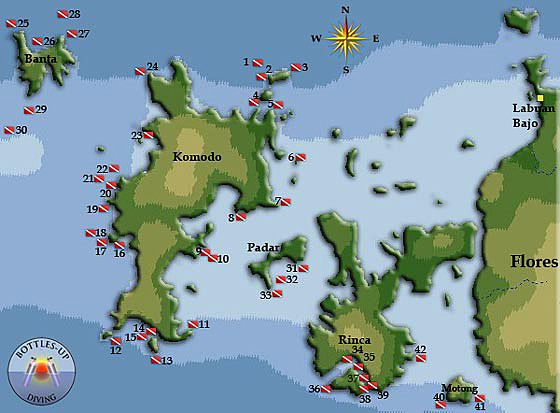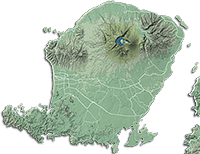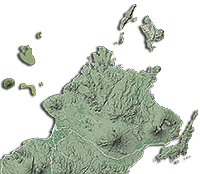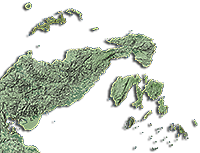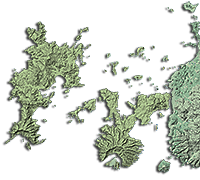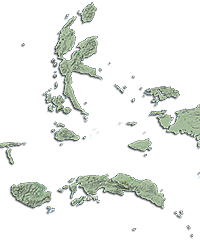Komodo islands - west of Flores
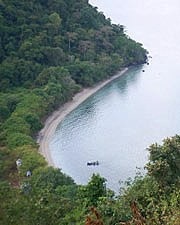
The Komodo islands is the name of all the islands within the borders of the 'Komodo National Park'. They include Komodo, Rinca, Padar and all the smaller islands totaling 603 km² of land.
The total size of Komodo National Park is presently 1,817 km² but there are plans to expand it.
Komodo National Park was established in 1980 and was declared a World Heritage Site and a Man and Biosphere Reserve by UNESCO in 1986.
The park was initially established to conserve the unique Komodo dragon (Varanus komodoensis), first discovered by the scientific world in 1911 by J.K.H. Van Steyn and which can be found on both Rinca and Komodo.
The majority of the people in and around the Park are fishermen originally from Bima (Sumbawa), Manggarai, South Flores, and South Sulawesi.
Those from South Sulawesi are from the Suku Bajau or Bugis ethnic groups.
The Suku Bajau were originally nomadic and moved from location to location in the region of Sulawesi, Nusa Tenggara and Maluku,
to make their livelihoods.
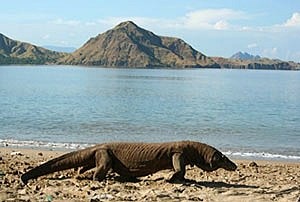
Descendants of the original people of Komodo, the Ata Modo, still live in Komodo, but there are no pure blood people left and their culture and language is slowly
being integrated with the recent migrants.
Visiting the islands can be done as a day trip from Labuan Bajo or as part of a boat safari around the islands. There is an entrance fee
for entering the park which varies on what kind of activities one does.
Komodo National Park (daily) entrance fee is:
Rp 150.000 (mon-sat) or Rp 225.000 (sun + public holiday)
In addition to that there are the following fees:
- a visit to Komodo or Rinca you pay an extra Rp 100.000
- for a guided tour (absolute must) add another Rp 100.000
- bring a camara add another Rp 50.000 or video camara add Rp 150.000
- diving around the islands add Rp 25.000 per diver
- snorkeling around the islands add Rp 15.000 per snorkeler
Dive conditions Komodo Islands
Diving in this area is definitely not for beginners. The currents are very fierce and there are nearly always down currents and large
eddies, whirls as well as swells.
For an explanation, click on Indonesian throughflow.
Indonesian throughflow
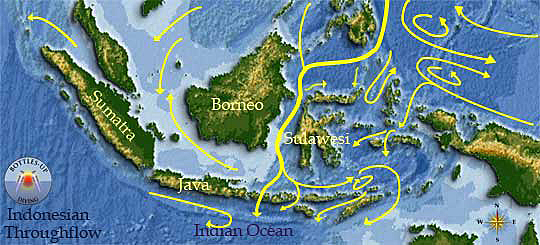
Geologically, Komodo and Rinca are part of Flores lying on a relatively shallow shelf and are separated from Sumbawa by the Sape
Strait where depths are almost 300m. This strait is one of the main channels for the Indonesian Throughflow (as is the Lombok Strait
between Bali and Lombok and the Ombai Strait between Alor and Timor), a water movement that starts in the Philippines, flows past
Sulawesi on the West and East and then hits the barrier of what is Nusa Tenggara (Lombok, Sumbawa, Flores). From here it finds its
way to the Indian Ocean in the South.
The Indonesian Throughflow is strongest during the South East monsoon (June, July, August)
which means, that currents can be really strong here, reaching up to 8 knots (1 knot = 1 nautical mile per hour = 1.852 km per hour)!
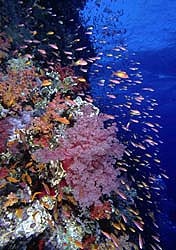
The water temperature ranges from 21°C to 27°C in the South, 24°C to 28°C in the middle
and 25°C to 29°C
in the North part of the park.
Better bring a 5mm wetsuit with hood and wear gloves if you want to dive in the South part of the park.
From November until January the visibility is at its best.
The months of January to February are not so good, there might be some rain.
Visibility in the North worsens and the South, although warmer than usual, can be difficult to reach because there often is a lot of wind.
There are some easy drift dives around the Komodo islands, but most of the interesting diving is done close to rocks or small islands
sticking out just a bit during low tide.
Usually you dive on the lee side, where the current is not so strong and where there are some areas where it is safe to ascend at the end of the dive.
The other side is usually inaccessible due to the fierce currents.
Still, this kind of diving is only for someone who knows how to handle currents!
You better have a safety sausage (inflatable signal device) along with you in
case you get swept off and away to the open ocean after a dive. Here you only dive with a qualified dive operator from the area!
Shark numbers are decreasing at a shocking rate.... What all people, especially divers, should know about the shark population.
Shark population
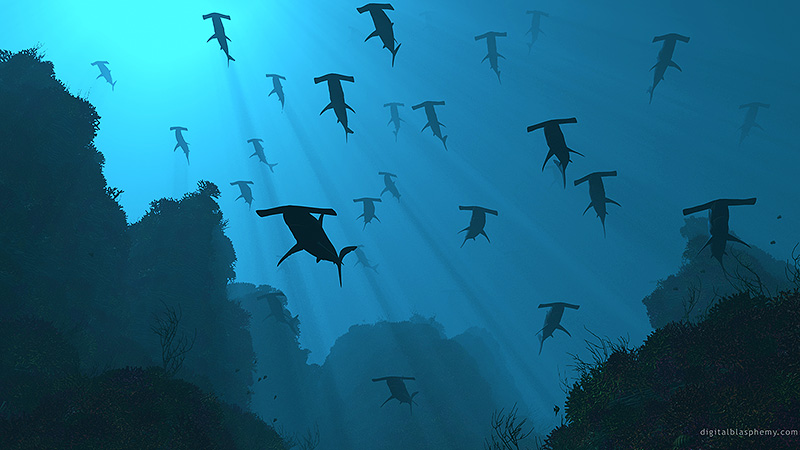
Most divers would love to see sharks, but should realize that there is a great slaughter amongst these apex predators happening every single day.
Indonesia ranks number 1 on the list of top 20 shark catchers.....
Diving in 1995 in the Bunaken national park we encountered sharks every dive. When we went back in 2008 we saw maybe 5 sharks on a total of 60+ dives!
When describing dive sites, we often mention that you might see sharks, but every year the chances are less..
An estimated 100 million sharks a year are killed, mostly for shark fin soup, says a shark researcher of the University of Windsor.
These are the shocking results done by the Institute for Environmental Research published in March 2013 in the journal Marine Policy.
The postdoctoral researcher, Steve Kessel, was part of this research team that came up with a more comprehensive estimate of the number of sharks being killed each year.
Due to the incomplete nature of the data for shark catches, that number could be as low as 63 million or as high as 273 million, but both the high and low end estimates are
considered outside of safe biological limits.
The study also found shark populations cannot reproduce fast enough to overcome that death rate.
There are about 400 species of sharks and 28% of them are threatened by extinction, Kessel said.
“One in every 15 sharks is taken every year”.
The Top 20 shark catchers in descending order are:
Indonesia, India, Spain, Taiwan, Argentina, Mexico, United States of America, Malaysia, Pakistan, Brazil, Japan, France, New Zealand,
Thailand, Portugal, Nigeria, Islamic Republic of Iran, Sri Lanka, Republic of Korea, Yemen.
Sources UNFAO, TRAFFIC 2013
Indonesia and India are responsible for over 20% of global catches between 2002 and 2011. Three EU Member States: Spain, France and Portugal, are among the top 20 shark catchers, responsible for 12% of global catches. Collectively, the 28 EU Member States are the largest shark catching entity of all.
Major hotels that continue to serve shark fin soup include:
Ritz Carlton-Hong Kong
Nikko hotels throughout Asia (headquartered in Japan)
Regal Hotels in Hong Kong
Prince Hotels and Resorts in Japan
InterContinental Group, a UK-based company
This list was comprised in conjunction with Wildlife risk.
Dive sites Komodo Islands
Use the map to jump to the dive site :Note:
the islands along the North Eastern fringe of the National Park can be reached on a day-trip from Labuan Bajo and are
therefore described in that section...
Castle Rock - [1]
Curious Batfish as well as schooling Barracuda, Trevally and Mackerel swim at 30-40m depth.
At approximately 20m depth there is excellent soft Coral growth and numerous sea Fans that can host the Pygmy seahorses.
The top of the rock is a good, calm place to explore during safety stops.
This site usually has excellent visibility but is prone to strong currents.
The current flows mainly eastwards and is much stronger at the surface than in the deeper water.
However, the top of the rock, which is approximately 3 to 4m deep, also offers shelter from the current; hence the name "Castle Rock".
Recommended dive entry point is in blue water approximately 50m up-current from the shallowest point of the reef.
Crystal Rock - [2]
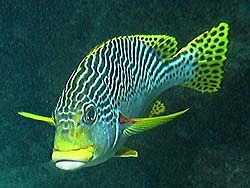
A very colourful dive with excellent soft Coral coverage. Clouds of Anthias and schools of Oriental sweetlips are always encountered
while Frogfish, Moray eels and Scorpionfish are commonly seen.
There is a small mound north-west of the rock where different species of fish schools seasonally, including Tunas and Mackerels.
An excellent dive usually worth doing twice.
The name of this site is from the very clear water surrounding it. The top of the site is exposed at low
tide and prone to currents, which usually flow eastwards.
Best time to dive is during slacktide.
Gililawa Laut - [3]
Always a great dive site to see fish but does not have much to show in terms of hard Corals. Behind a very large rock on the corner of the reef is a drop-off covered in boulders and many holes in between with hidden animals. Excellent Grouper sightings, especially in October and November during spawning aggregations. There are usually many Golden trevally, Snappers and sometimes huge Napoleon wrasse.
The site is located on the north-eastern tip of Gililawa Laut. The best time to dive this site is when there is a slight current just before or after slack-tide.
Darat Passage north, Gililawa Darat Island - [4]
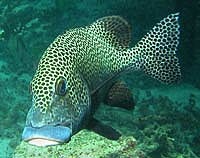
The reef slope is very rich in marine life and the sandy bottom at 15m depth is covered in Garden eels.
On the approach to the channel, Turtles may be seen as well as a school of Giant sweetlips that live in a cave near the surface of the water.
Around the south-west corner of the island, the shallow reefs are extremely rich and full of fish life. Bumphead parrotfish are commonly seen and aggregate
here to spawn annually around the month of April.
Sharks and schools of Batfish also reside in the passage. A large Coral head about two
thirds of the way through the dive teems with life and activity.
An excellent drift dive and good snorkeling can be found on the northern side of the channel between Gililawa Darat and Komodo Island.
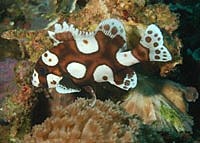
The dive can be done from east to west or vice versa depending on the current. The visibility is usually better if diving from west to east.
Best to dive just before or after slack tide when the current is not too strong.
Best diving entry point is on the reef slope on the west side of Gililawa Darat Island, about 100 metres
north of the channel.
Swim towards the south-western corner of the island where the current is predominantly gentle.
The sandy bottom starts at 15m depth then drops away to about 35m before rounding the Southern corner of the island and into the channel.
Recommend to stay shallow and on the northern side of the channel as the deeper section of the channel has rubble, boat traffic and a downcurrent at the end of it.
You will gradually get closer to the island towards the end of the dive where the current eventually decreases.
Darat Passage South - [5]
At 20-25m depth to the south of the point, many small Coral groupers, large schools of Anchovies and small Tuna and Trevally come in to feed in the bay.
Many times turtles are hanging around on this beautiful stretch of Coral reef.
Deeper along the bottom of the slope fish life increases; Garden eels sway and White-tip reef sharks sleep on the sandy bottom near the point.
Good snorkeling here although a lot of damage has been done by fish bombing.
The best time to dive is when the current is running from east to west through the narrow passage between Gililawa Darat and
Komodo Island.
The best place to see many fish while snorkeling is at the tip of the point with Gililawa Bay a good anchorage for boats.
Karang Makasar - [6]
This site is for snorkeling only, please don't dive here as it will disturb the Manta rays.
The reef does not have much in the way of Coral or fish life however this location is a Manta ray aggregation site.
Dive-boats cruise along the eastern face of the reef until they spot the Manta rays at the surface: time to jump in the water.
The best time is during rising tide when there sometimes can be up to 40 Manta rays.
Batu Tiga - [7]
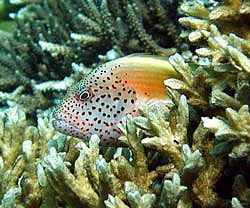
An excellent "big fish" dive. Large boulders in deeper water to the West offer excellent habitat for Groupers and other creatures.
Frequently visited by Manta rays, Giant Trevally and other pelagic marine life. Coral growth is stunted as a result of the strong
prevailing currents.
Batu Tiga is without a doubt one of the most current-effected sites in Komodo and is tricky to dive.
A rocky reef is situated south-east of Tanjung Kuning in Linta Strait and extends below the surface up towards
Komodo Island.
The best diving entry is at the north-eastern side of the three rocks. Swim counter-clockwise until reaching some big boulders at 33m depth.
After exploring the area around these boulders turn around and swim back, keeping the reef to your right.
Pantai Merah / Pink Beach - [8]
There as a great variety of fish here and also a good selection of critters such as Leaf scorpionfish, blue Ribbon eels,
Crocodile fish, Nudibranch and more. Visibility varies but is best during falling tide.
This is the most frequently visited site in the Park for snorkeling and diving.
Snorkeling is excellent from the beach and there is a very good dive at a small area of reef around a
steep rocky wall which is visible from the surface of the water at low tide.
This site is also a very good night dive and offers
excellent macro-photography opportunities. Several mooring buoys are stationed at this site.
Loh Namu - [9]
An excellent site for Groupers and Napoleon wrasse. Most of the fish on this reef are found near
the southern corner where some large boulders spread out over the drop-off.
A few caves also offer hiding places for interesting marine life. Some of the largest Coral grouper
schools seen in the Park are here along with Malabar groupers and huge Napoleon wrasse, which may aggregate here to spawn. You may
also find a Giant clam (Tridacna gigas)at 8 metres depth.
Dive around the point of Loh Namu peninsula from south to north at a depth of about 28m, and always just before high tide.
Indihiang - [10]
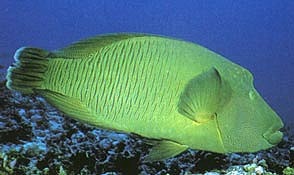
Many big fish and good Coral diversity can be seen when drift-diving along the steep walls.
Top attractions include Potato cods, large Napoleon wrasse and schools of Giant trevally and Snapper.
This small island with steeply dropping walls is close to Loh Liang and an ideal location for divers starting from Komodo Island.
This dive has to be planned around slack tide to avoid excessive currents.
The best time to dive here is at the end of falling tide when the current has slowed down and allows an easy north to south drift dive
along the eastern wall.
Tanjung Loh Sera - [11]
Large fish like Dogtooth tuna can be seen circling off the point and around the pinnacles.
Turtles and large fish such as monster-sized Giant Trevally, Potato cods, Malabar groupers, schools of Bumphead parrotfish, Napoleon wrasse,
Manta ray and much more can be seen along the wall.
Superb diving all along the southern point of Loh Sera, or off the point towards underwater pinnacles.
Due to potentially strong currents only experienced divers should attempt to swim to the pinnacles. Beginner divers should stay along the
wall. Great snorkeling along the northern shore of this cape.
Langkoi Rock - [12]
This site can be a real adrenalin rush at the right time. Many Sharks such as Grey reef sharks, White-tip reef sharks,
Hammerheads and Bronze Whalers aggregate around this site from July to September.
Also a potentially good place to see the resident Potato cods at the southern point in 30 metres of water.
This submerged pinnacle dive is located south-east of Langkoi Island.
The site is very exposed to current and sometimes to big surge.
Usually a swell banks up against the pinnacle but on a calm day the site can be difficult to find.
A GPS position is recommended as the pinnacle is not marked on most charts of the area. The rock rapidly plummets
into very deep water.
Best diving entry is to jump in upcurrent from the pinnacle, dive straight down, hang on the wall and watch the
show of fishes. This dive should not be attempted by inexperienced divers.
South Tala - [13]
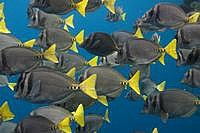
Abundant small fish life at shallower depths, interesting invertebrate life on the walls and
lots of larger fish somewhat deeper.
Enormous schools of Surgeon fish sometimes obscure views. Schools of large Red snapper, White-tip reef shark and huge Groupers further
down amongst the boulders frequent the reef.
The southern point of Tala island is characterized by steep rocky walls and occasional strong surge.
German Flag - [14]
From September to January high densities of plankton attract many large Manta rays that can normally be seen swimming at the surface
along the shores and rocks along southern Komodo Island.
The near shore water is quite shallow (5-20m deep) and is composed of large
rocks and boulders that shelter huge Malabar groupers, Potato cods, Napoleon wrasse, schools of Surgeonfish and Red snapper. Cooler
water from the upwellings off the south coast provide a nutrient-rich environment in this area.
There is usually current at this site
and a drift dive is the best way to go.
Manta Alley - [15]
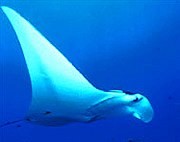
This area is marked with very large Giant trevally, Sharks, beautiful Coral and a high diversity of other invertebrate life in relatively shallow water between 5-20m depth.
The place to watch the elegant Manta rays feeding here between September and January each year.
The tiny rocky islands in this southern Komodo bay are great for snorkeling and diving, even if there are no Manta rays.
The alley itself is mostly rocky with some Coral outcroppings and, when the currents are strong, difficult to stay in one place if you not in possession of a hook or stick. The best diving entry point is on the northeastern side of a rock located near a Coral mound that is submerged 3-5m below the surface The temperature of the water can drop to the low 20°C range and this site tends to be current-prone.
Letuhoh Reef - [16]
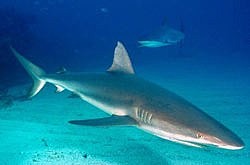
Big Potato cods, Grey reef sharks, Eagle rays, Turtles, schools of Rainbow runner, Dogtooth tuna, Giant trevally and Snapper frequent
this reef. There are also large Coral-encrusted pinnacles.
This reef extends south from Tanjung Letuhoh and consists of big boulders and pinnacles that offer some of the best big-fish diving in Komodo.
The optimal time to dive is during falling tide when a counter-current flows northwards.
Recommended dive entry is on the southern-most rock that breaks the surface.
Hang out on the reef face and watch the show, which is particularly good at around 30m depth. Swim clockwise around the rock where you will encounter some
big pinnacles encrusted with Corals.
This site is affected by surge and can look quite frightening from the surface especially when
there is a big swell running; however, conditions are less terrifying underwater.
Toroletuhoh - [17]
There is a nice wall as you approach a point with plenty of Sharks and big fish including Giant trevally
and schools of Snapper.
There is also an excellent variety of Coral reef fishes. The Coral-encrusted growths are very similar to those found on southern Komodo
reefs. The best time to dive this site is during rising tide when a counter-current flows southwards.
The entry point is on the north-eastern side the point. The dive drifts counter-clockwise along the boulders to the most western most of the point.
The water here is usually clear but can be quite cool. Also the site maybe effected by a strong surge when there are large swells.
Nisaleme Island - [18]
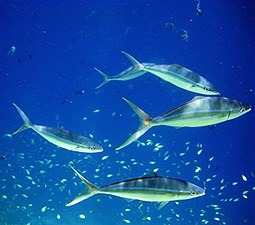
An excellent site for Rainbow runners, Giant Trevally, Dogtooth tuna, and Sharks. Nisaleme is a very exposed,
small, rocky island that can be difficult to dive.
The entry point is usually at the Northern or the Southern tip of the island depending on current direction.
The rock itself plummets very steeply into deep water. Caution should be taken when attempting this
dive as there can be strong down-currents during rapid tidal flow.
Batu Saloka - [19]
The terrain is very dramatic and the fish life is prolific. Napoleon wrasse, big Groupers, schooling Snapper, Turtles, big Sharks, and Giant Trevally are encountered here.
This site is part of a cluster of uncharted rocky islets and reefs off the point of Tanjung Saloka. The western-most islet is an excellent dive site although it is very susceptible to currents and swell. There is also a rocky reef just below the surface, fifty metres south of this island. Best time to dive is during slack tide when you circle the rock.
Banana Split - [20]
A variety of Sweetlip species live on this site and sometimes school together. Groupers, Sharks and other pelagic species are around.
There is a lot of activity amongst the smaller reef fish around the top of the reef. Thousands of Anthias and Wrasses can often be seen
spawning.
The top of the reef is shaped like a banana and runs north to south at a depth of 2m. The western side of the reef
drops down to boulders in approximately 30m of water where the bigger fish live. On the eastern side of the reef, boulders start in
approximately 10 metres of water and slope down. At the southern end of the reef is a pinnacle detached from the main reef.
Tukoh-Lehokgebah - [21]
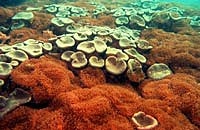
This site has good Coral coverage and plenty of small fish and Sharks.
There is good diving on the northern and southern points of the island.
The diving environment is very similar to Tukoh-Serikaya.
On the southern side of the island there are some big boulders that form an interesting terrain.
Coral growth on the northern side is also very good but stunted due the force of the current that sweeps the island.
Tukoh-Serikaya - [22]
The Corals are in very good condition and fish life is also very good.
Lots of a White-tip reef sharks patrol the area, which is surrounded in clouds of Anthias.
This site is one of the better small island dives in western Komodo. On the eastern side of
Tukohserikaya there is a rocky reef that break the surface. Although this site is very exposed to the current, it is still possible
to dive on the lee side of the reef even when the current is otherwise quite strong. The best time to dive this area, however, is
during slack-tide.
Lohwenci - [23]
A good variety of hard and soft Corals, plenty of fish life and other marine creatures can be found at this site.
This site is a pleasant, relatively current-free dive just north of the ranger station where there is a small white sandy beach and a group
of low, black rocks sitting on the reef.
The entry point is just off the small white beach. The dive continues towards the ranger station
with the reef at your left.
Toroh Moncong - [24]

We have not dived here nor have we any information on this dive site....
Tanjung Rasa - [25]
A variety of small invertebrates and fish, including Sharks and Giant Trevally, are visible while snorkeling the rocky slopes. Deeper diving to 40m reveals many Coral groupers and massive Dogtooth tuna.
Ideal entry is approximately 100m south of the bay´s western point. Once you have rounded the point, continue diving westwards. The shallow reef at the end of the dive is an excellent Coral garden.
Strong currents and sometimes down-currents can be experienced on the point. Recommended time to dive is during slack-tide.
Tondok Rasa - [26]
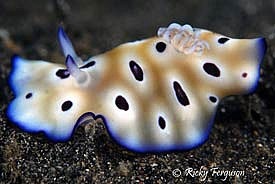
Because of its sheltered location away from the fierce currents perfect opportunity for a night dive. Lots of little critters and Nudibranchs; enough to make you want to go for another dive!
Toro Oi - [27]
Excellent hard Coral garden. Frogfish can be found on Sponges on the reef slope. Nudibranchs and other unusual creatures are often found in this area. Entry point is at the northern tip of the headland. Swim along the reef heading into the bay with the reef to the left.
GPS Point - [28]
Abundant fish life still exists in current-prone areas including large, missile-like Spanish Mackerel. On the north western corner of this seamount Grey reef sharks swim at 30m depth. Dogtooth tuna can sometimes be seen along the deeper slopes.
This seamount was once rated amongst the best dive sites in this area. Up to 7 species of Sharks could be seen during a single dive
and schooling Hammerhead sharks were seen in the month of September.
Unfortunately, hard Corals where severely damaged by dynamite fishing in 1997 and 1998 and Sharks were extensively fished out by sharkfinners.
Large patches of Coral rubble intersperse stretches of life Coral, which are evidence of what a great site this once was.
Galley Rock - [29]
This dive site can be difficult to enter because of the occurrence of whirls and currents. Again a great
site with reef Sharks, large Tunas, Barracudas.
Depending on the currents you enter either at the north or the south side of this rocky
outcrop. It starts with a gentle slope, then a wall and at 30m flattens out again with large Barrel sponges.
Batu Boso - [30]
Again a challenging dive with fierce currents. Lots of different sorts and sizes of Sharks, Mackerels,
Tunas and so on. Best to dive here right at the change of tides.
Although not for the fainthearted a highly recommended dive site...
Payung Island - [31]
Very interesting underwater landscape with huge rocks that give the illusion of a wreck dive. There are many canyons and crevices to
explore.
Fish and invertebrate life is diverse and abundant. There are big schools of Surgeon fish and smaller Yellow Snapper.
Rocky reefs are covered with soft Coral, Gorgonians and Feather Stars.
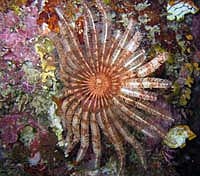
The southern and western sides of Payung island offer the most interesting reef scapes. A rock in the shape of a cannon lies at 5m depth on the
southern tip of the island. As with most dive sites in the southern section of the Park, visibility is relatively low (5-10m) and the
water is cooler (low to mid 20°C range).
This site should be dived at slack-tide, preferably during slack of the low tide.
Two dives are possible: the first dive descends at the north-west tip of the island (near the rocks that nearly break the surface)
and continues south (with the slope on your left) at 15-30 metres depth, then turns at the southern-most end of the island and ascends to 10m depth.
The second dive starts at the southeastern side of the island and proceeds around the southern tip of the island at 20-35m depth, then
ascends to 5-15m depth.
Three Sisters / Tiga Dara - [32]
A pristine reef with excellent Coral coverage and rich fish life. Located north of Pillaarsteen,
there are three very large submerged rocks about 10m apart and within easy swimming distance of each other.
The rocks run in a line about 100 metres east of a small reef that juts out on the eastern side of the island.
The rocks sit on a sandy bottom in about 20-25m of water and rise to 3-5m from the surface of the water.
The site can be hard to find as its not marked on any charts and the rocks lay just below the surface. This
site is current-prone but can be dived almost any time if you are willing to swim.
For the adventurous there is actually a fourth
sister located further to the west that starts in about 20m of water and then drops down to 40m with some impressive sea Fans and good
marine life around it.
Pillaarsteen - [33]
Very interesting reefscape. Large schools of Fusilier can be found here along the reef slope, which is covered in an interesting
variety of soft Corals. Sharks and the odd Turtle are often encountered. Pillaarsteen is a rock pinnacle located on the shore of a
small island east of Padar Besar.
Best diving entry is just off the point below the rock where there is a nice wall. Continue swimming
to the west towards interesting caves and swim-throughs at different depths. Diving is particularly good at around 30-40m depth. This
site is a good choice when other sites have too much current. This area may be effected by surge when there are swells from the south-west.
Torpedo Point - [34]
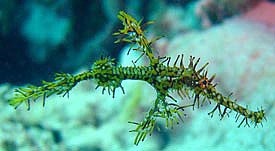
An excellent place to find unusual critters such as Torpedo rays (Torpediniformis, Electric ray),
Bobbit worms, Frogfish, and Ghost pipefish.
Located north of Cannibal Rock, critters can be found on a patchy rocky reef at a depth of 15m.
A great low environmental-impact dive for photographers as most of the rocky habitats are surrounded by sand.
Cannibal Rock / Batu Buas - [35]
This site is famous for its varied and colourful invertebrate life. Rich soft Corals abound as well as Sea apples and other sea Cucumber
species. Amongst many surprises are flamboyantly coloured Nudibranchs, and Fire urchins with Coleman shrimps.
The fish life can also be quite good at times with an array of Scorpionfish, schools of Red snapper and Surgeonfish.
Unusual creatures such as Pygmy seahorse and Frogfish may also be seen.
Cannibal Rock is a small seamount in the well protected Loh Dasami Bay, between Rinca and Nusa Kode, which
allows for easy diving with little current. Night dives are excellent, especially on the sandy slope of the northern side of the island
starting at about 25m depth.
Nusa Kode - [36]
The south western tip of Kode island is characterized by large, Coral-encrusted boulders and huge Groupers.
Amongst the boulders are some of the largest reef fish residing in the Park such as gigantic Potato cods and Malabar groupers.
Schools of large Red snapper are normally prevalent.
Diving entry is west of a small island at this site. Swim down to a depth of about 10m and follow the ridge, which
juts out in a southerly direction. Swim along the crest of the ridge and down to a max of 50m depth.
Boulders - [37]
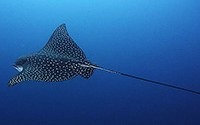
The dive begins with forests of soft Coral at 30-35m depth. Along the way to the boulders is the best place in Loh Dasami to find Fire urchins with Coleman shrimps.
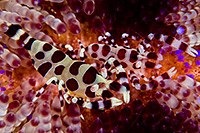
The boulders themselves have good Coral, invertebrate and fish life. Quite often Manta and other Rays can be seen in
this area as well.
This site is located on Nusa Kode where the bay widens just north-west of Crinoid Canyon.
Directly below this point there are several big boulders laying on the bottom. The shallowest boulder is in about 8m of water and the deepest one is in about 30m of water. A torch is useful on this dive.
The best point of entry is 100 metres south of the point where the reef slopes down to soft Coral forests on a dark sandy bottom in 30 to 35m of water. Continue the dive to the boulders by ascending to 20m with the reef to the left. This is also a good night dive location.
Crinoid Canyon - [38]
Many kinds of small invertebrate life can be found here on very colourful walls carpeted in Feather stars. This site is located in a
small cove just outside the southern entrance of Loh Dasami on the island of Nusa Kode, almost directly opposite Yellow Wall.
The diving entry point is just south of the cove then continues along the wall in a counter-clockwise direction. Best to start the dive
at 25m depth and then continue swimming back and forth up along the wall to the surface.
This is an easy dive location with no current
and is good in the early morning as it catches the morning sun.
Yellow Wall - [39]
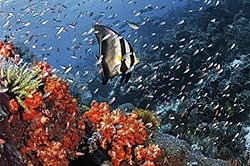
A very good place to see an amazing amount of invertebrate diversity, especially during a night dive.
Walls are packed with a mind-boggling array of marine life and colours including colourful Sea urchins, bright red Sea apples,
beautiful soft Corals, Spanish dancer, Nudibranch and a great variety of Sea squirts.
Crevices in the wall reveal sleeping fish, Spiny and Slipper lobsters, Cleaner shrimps, and Decorator crabs.
Nighttime fish life include sleeping Coral groupers, Cat sharks (Scyliorhinidae), all kinds of Cardinalfish and Parrotfish
in their mucus cocoons, as well as sleeping Turtles.
Yellow Wall is an excellent day or night dive spot just inside the southeastern corner of Loh Dasami Bay.
It is also one of the best areas in Loh Dasami for snorkeling. The current usually flows south to north so the best entry point is just
around the western-most tip of the headland; the dive should then continue into the bay along with the current.
Apple Orchard - [40]
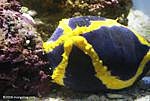
This site is special for the filter-feeding sea Cucumbers called Sea apples (Pseudocolochirus violaceus.
This sea Cucumber is round and of a bright red and purple color with white or yellow stripes. They feed on plankton which they catch
with their tentacles. That these Echinoderms are referred as "cucumbers" derives from the fact that around Asia they are known under
the name of trepang and used as a base for soups. The live animals are dried in the sun or in ovens and then the leathery skin becomes
a sort of gelatinous substance during the cooking process.
Kerita Tol - [41]
We have not dived here nor have we any information on this dive site except that there is a chance to see Manta rays and even (lottery chances we guess..) a Whale shark. Visibility is supposedly poor and the water very very cold!
Toro Sie - [42]
On the south west coast of Rinca you will find a point marked Toro Sie. Adjacent to the point is a rock awash. This rock has a ridge
that extends to the West that is covered in Crynoids and soft Corals. On the seabed around the rock lots of interesting critters can be
found.
If you swim out over the sand south-west of the rock, there is a patch reef that usually has excellent fishlife on it and quite
often a few big Groupers. This dive has better visibility during the NW monsoon along with most of the Parks other southern sites.
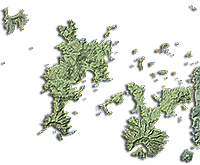
Other locations
Other dive locations which can be reached easily from Bali or direct from your home country...

